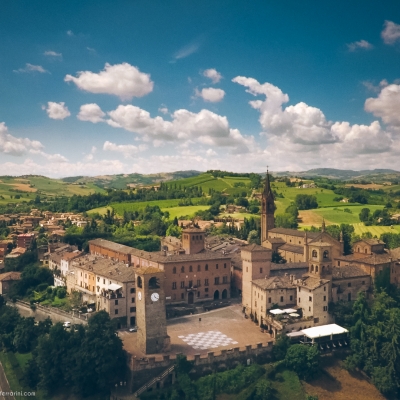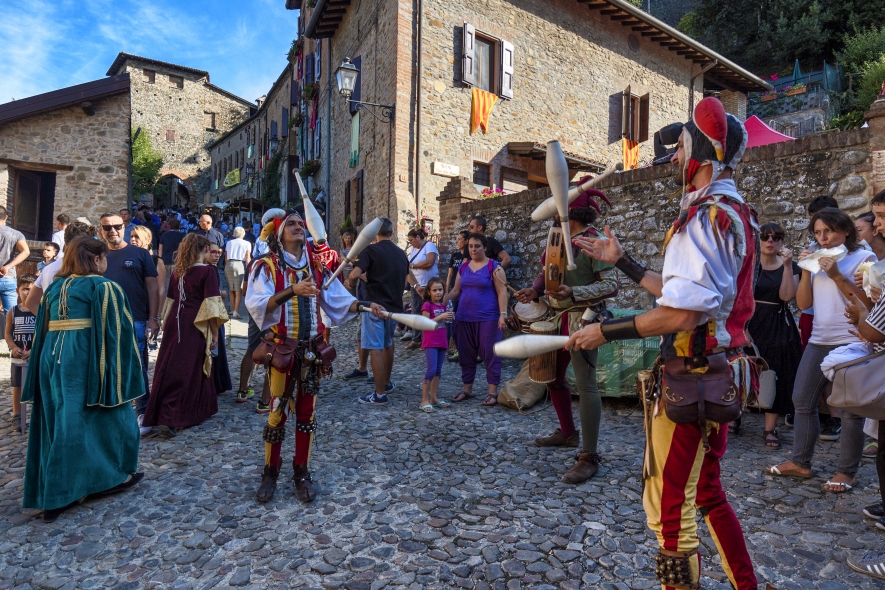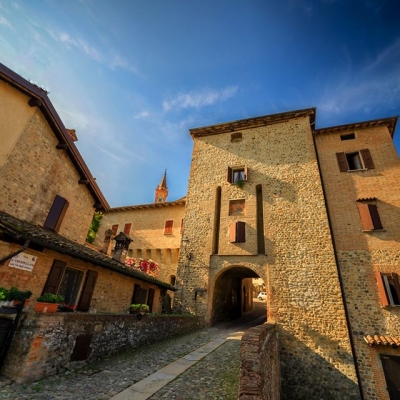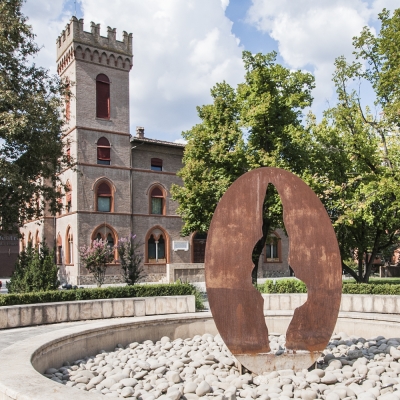
Savignano sul Panaro and Castelvetro di Modena: historical re-enactments in Terre di Castelli
First-hand experiences to learn more about history.

A journey back in time, a magical opportunity to relive the history of the area. These are the historical re-enactments of Savignano sul Panaro and Castelvetro di Modena, an opportunity to discover ancient crafts and to recall events that really happened.
Somewhere between entertainment and an educational experience, historical re-enactment is an event that will engage you by allowing you to experience history first-hand.
It is a cultural enrichment aimed at enhancing the territory and its intellectual identity, an opportunity to inspire a sense of belonging and active participation. Like a visit to a museum, re-enactments promote and spread stories and traditions, enhancing the local heritage through atmospheres, colours, customs, flavours and deeds of the past.
There are also events in Terre di Castelli that are attracting increasing interest. Among the most popular and appreciated are the Battle for the Contrary Sword (it. Lotta per la Spada dei Contrari) in Savignano sul Panaro and, in alternating years, the Living Draughts (it. Dama Vivente) and the Castle Feast (it. Festa a Castello) in Castelvetro di Modena.
THE BATTLE FOR THE CONTRARI SWORD

‘In a borderland crushed by the pressing hills and strictly marked by the uncontrolled riverbank, this strip of land, Savignano, was created. Here, for war needs or noble quirks, the borders of powers were erected to touch larger interests than the two neighbouring cities, Modena and Bologna; Guelphs and Ghibellines alternated their power over the ancient village.’ (source: http://www.aerrs.it/manifestazioni/lotta-per-la-spada-dei-contrari/)
Thus began the long story that took Savignano back to 1409, the year in which the feud was donated by Marchese Niccolò III d'Este to his captain Uguccione dei Contrari. The latter, lord of Vignola, had obtained it by wresting it from the Savignani family.
During this event, organised every year by the Borgo Castello Non-Profit Association, the town's six contradas (Castello, Doccia, Formica, Garofano, Magazzeno and Mulino) challenge each other in games of ability and strength: the race of discord, the cross-cut saw race, tug-of-war, the plank race and the surprise final saraband. This last game is devised in great secrecy by the contrada that came last in the previous year's sword battle. The aim is to gain an advantage and put the rivals whose weaknesses are known, in a difficult situation. Precisely for this reason, the final game is only revealed to the other contradas on the day before the re-enactment. The prize to be won is the Contrari Sword awarded by the Marchese in the village church.
For the occasion, the village is decorated with heraldic coats of arms, comes alive with touring fancy-dress shows, duels, mediaeval markets, military camps and inns where you can dine on tigelle, borlenghi, mixed grill, gnocco fritto, tortellini, pasta with beans and other typical products.
The historical re-enactment allows visitors to attend the court of the Marchese d’Este entertained by jesters, jugglers, flag wavers and falconers. The costumes of the artists tell us about the customs and arts of the past.
For some years now, children from the contradas have also been taking part in the re-enactment trying to win the Sword.
Almost thirty years after its first edition, the Battle for the Contrari Sword has reached an important level of popularity, attracting numerous visitors and benefiting the entire community.
THE LIVING DRAUGHTS

For over 50 years, a special game of draughts with living draughtsmen has been played in Piazza Roma in Castelvetro di Modena. The Living Draughts brings back to the shadow of the two ancient towers the charm and beauty of the 16th century with shows, a pageant and spectacular aerial and vertical dances with fireworks at the end.
During this historical re-enactment, which takes place exclusively in even-numbered years, starters, ladies and knights bring back to life the feast organised by the Marchesi Rangoni in honour of the poet Torquato Tasso. History tells us that it was here, in 1564, that the playwright fleeing from Bologna and taking refuge in Castelvetro found inspiration to compose one of the most evocative passages of Jerusalem Delivered: the Canto of Erminia among the shepherds (seventh canto).
The Living Draughts is an accurate event studied with an almost philological historical thoroughness, celebrating the draughts games between the lords of the court exactly as they were organised at the time with living draughtsmen, becoming real tournaments between the Rangoni and the Montecuccoli families, lords of Frignano.
It was with this kind of games and shows that Renaissance courts liked to 'dodge boredom', turning board games into open-air tournaments and allowing the population both to watch as an audience and to actively participate (e.g. as a draughtsman).
In recent years, the Dama Vivente association has achieved great success in Italy and abroad for the collection of costumes carefully worn by the participants. The Renaissance-style costumes are entirely hand-embroidered and can be admired in the permanent exhibition Fili d'oro a Palazzo in the historical centre of Castelvetro. This appreciation of historical and artistic heritage has led the association to win the Rocchetto d'Oro national period costume competition several times.
CASTLE FEAST

In odd-numbered years, Piazza Roma has been hosting the traditional Renaissance-style banquet of the Castle Feast for fifteen years now. This is a new, charming event, again organised by the Dama Vivente association, which, as per tradition, requires participants to be strictly dressed in 16th century-style costumes in order to immerse themselves in the right atmosphere.
Juggling shows, fire-eaters, musicians and stilt-walkers entertain guests in between courses of traditional food served by menservants and maidservants. There is no shortage of banquets of ancient crafts to recreate the typical atmosphere of the Living Draughts.
As of this year, even the ones who do not attend the banquet will have the opportunity to experience the atmosphere of that time by attending the shows. Local restaurateurs will propose a themed menu.
Castelvetro di Modena thus became the stage for important historical re-enactments with the goal, always achieved, of publicising and spreading the culture of the Renaissance by stimulating the tourist and cultural promotion of the historic centre.
HISTORICAL RE-ENACTMENTS AS HERITAGE ENHANCEMENT
The success of re-enactments in Terre di Castelli is also due to the commitment of the communities that organise these events. A careful study of history, skilful craftsmanship and theatrical skills make it possible to faithfully recreate and perform the main aspects of the daily life of the people lived in the past.
The care of the costumes and weapons, the interpretation of the characters, the words and gestures of the past intrigue the participants and tell of the community's passion for a type of event that allows the identity, history and culture of this area to be presented and preserved with pride.
LEARN MORE:
MEDIEVAL VILLAGE OF SAVIGNANO
Thanks to conservation work, this important historical testimony is now one of the most fascinating villages in the province of Modena. Highlights include the Oratory of San Rocco, the House of Matilde, Piazza Zanantoni, the House of the Captain and the castle. Frescoes and sculptures make Savignano an artistic place to visit with interest.
THE ANCIENT VILLAGE OF CASTELVETRO DI MODENA
The beating heart of the town is the square known as the 'Piazza della Dama' (lit. ‘Draughts Square’) due to its black and white paving stones. It is overlooked by the Clock Tower, the Prison Tower, Rinaldi Palace and the Town Hall. The parish church, built from 1897 onwards and consecrated in 1907, has typical neo-Gothic features.

